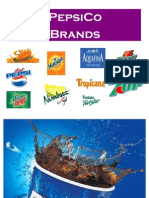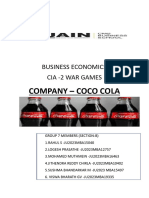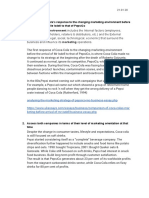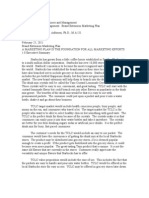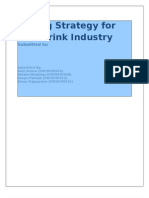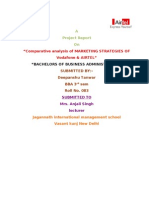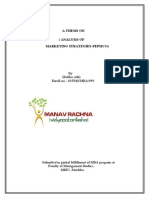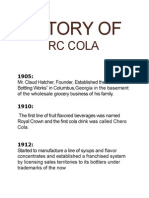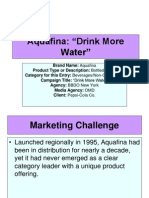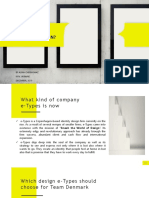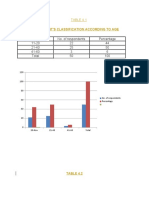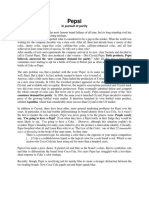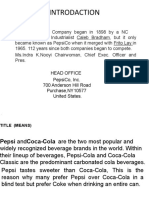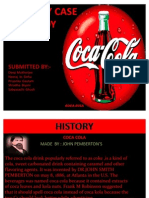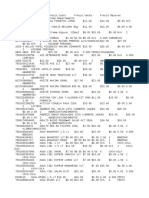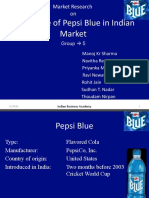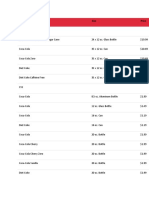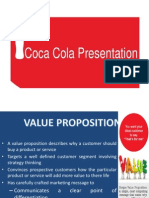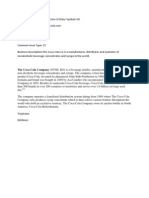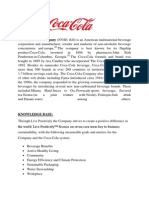Idea Failure Pepsi Crystal
Idea Failure Pepsi Crystal
Uploaded by
Ajit RunwalCopyright:
Available Formats
Idea Failure Pepsi Crystal
Idea Failure Pepsi Crystal
Uploaded by
Ajit RunwalCopyright
Available Formats
Share this document
Did you find this document useful?
Is this content inappropriate?
Copyright:
Available Formats
Idea Failure Pepsi Crystal
Idea Failure Pepsi Crystal
Uploaded by
Ajit RunwalCopyright:
Available Formats
Pepsi: In pursuit of purity
Coca-Cola may have one of the most famous brand failures of all time, but its long-standing rival has also had its fair share of marketing mishaps. For instance, in 1992 Pepsi spotted what it considered to be a gap in the market. What the world was waiting for, the company decided, was a clear cola. After all, there had already been a variety of diet colas, cherry colas, sugar-free colas, caffeine-free colas, caffeine-enhanced colas, and all had achieved at least some form of success. So why not a clear cola? After months of tests and experiments the company arrived at its new, clear formula and decided to call it Crystal Pepsi. They also produced a diet version Diet Crystal Pepsi. Both products, Pepsi believed, answered the new consumer demand for purity. After all, this was a time when consumers were starting to opt for a bottle of Evian or Perrier just as often as they were picking up a bottle of Coke or Pepsi. The only problem was that a product with the word Pepsi in its name was expected to taste like, well, Pepsi. But it didnt. In fact, nobody seemed to know what it tasted of. Anyway, after a little more than a year, Pepsi halted the production of Crystal Pepsi and started work on a new clear formula. In 1994, the reworked product appeared on the shelves, branded simply as Crystal, and available only in regular. However, the negative associations persisted and Crystal mark two did even worse than its unpopular predecessor. Pepsi eventually admitted defeat and scrapped the whole concept of clear cola. But never one to give in easily, Pepsi remained aware of the new consumer demand for purity. In 1994, the same year it launched Crystal, Pepsi decided it wanted a piece of the growing bottled water market. It therefore launched its own bottled water product, entitled Aquafina, which had considerably more success than Crystal in the US market. In addition to Crystal, there have been other, more general marketing problems for Pepsi over the years. In particular, it has had trouble differentiating its brand identity from Coca-Cola. As it wasnt the first to market the cola category, Pepsi was never going to be the generic name. People rarely say, Im going to have a Pepsi. Even when they have a Pepsi bottle in their fridge they would be more likely to say, Im going to have a Coke. However, although this situation couldnt be avoided, Pepsis branding for many years failed to give the product a stand-alone identity. Crucially, Pepsi breached what Al and Laura Ries refer to as The Law of the Color, one of their 22 Immutable Laws of Branding in the book of the same name. As they state: There is a powerful logic for selecting a color that is the opposite of your major competitors [. . .] Cola is a reddish-brown liquid so the logical color for a cola brand is red. This is one reason why Coca-Cola has been using red for more than a hundred years. Pepsi-Cola made a poor choice. It picked red and blue as the brands colours. Red to symbolise cola and blue to differentiate the brand from Coca-Cola. For years Pepsi has struggled with a less-than-ideal response to Cokes colour strategy. Recently, though, Pepsi has sacrificed red for mainly blue to create a stronger distinction between the two leading brands. Now Coca-Cola equals red and Pepsi equals blue.
Lessons from Pepsi
Dont assume that gaps should always be filled. If you spot a hole in the market, it doesnt mean that you should fill it. Just because clear cola didnt exist, it didnt mean it had to be invented. However, the previous success, the company had with its Diet Pepsi product (the first cola of its kind) had convinced Pepsi that there were more gaps to fill. Dont relaunch a failed product. Crystal failed once, but Pepsi still believed the world was crying out for a clear cola. The second version fared even worse than the first. Differentiate yourself from your main competitor. For years Pepsis visualidentity was diluted through its red and blue branding.
You might also like
- Case Study Cola Wars in ChinaDocument5 pagesCase Study Cola Wars in ChinalumiradutNo ratings yet
- Pepsi Blue ProjectDocument29 pagesPepsi Blue Projectpujaguha2467% (3)
- Pepsico Background: Competitor AnalysisDocument32 pagesPepsico Background: Competitor AnalysiskimimuraNo ratings yet
- Annexure 2 PDFDocument7 pagesAnnexure 2 PDFHarishNo ratings yet
- Coca Cola DistributionDocument19 pagesCoca Cola DistributionRituraj Acharya100% (1)
- Pepsi Structure and DesignDocument5 pagesPepsi Structure and DesignNida Siddiqui80% (5)
- SupplyChainManagement - BlueBandDocument22 pagesSupplyChainManagement - BlueBandatif_810% (1)
- Strategic Integration QuestionnaireDocument1 pageStrategic Integration QuestionnaireAmy FitzpatrickNo ratings yet
- Pepsico BrandsDocument42 pagesPepsico Brandsshiprag_21No ratings yet
- Competitive AnalysisDocument4 pagesCompetitive AnalysisDharmin Shah50% (2)
- Crystal PepsiDocument2 pagesCrystal PepsiFariha AnsariNo ratings yet
- Crystal PepsiDocument6 pagesCrystal PepsiKathrynne Palma100% (1)
- Distribution Channel of RC ColaDocument19 pagesDistribution Channel of RC ColaPanner SelvamNo ratings yet
- Company ProfileDocument35 pagesCompany ProfileVIJAYA SURYANNo ratings yet
- PepsicoDocument50 pagesPepsicoMohammed Saad MemonNo ratings yet
- AcknowledgementDocument6 pagesAcknowledgementMaria JavedNo ratings yet
- Coco Cola BepDocument18 pagesCoco Cola Bepmohamedmuthmein23No ratings yet
- Pepsi Marketing StrategyDocument35 pagesPepsi Marketing Strategymchauhan1991No ratings yet
- Coca Cola Vs PepsiDocument4 pagesCoca Cola Vs PepsiMy HuỳnhNo ratings yet
- Pepsi: Promoting Nothing: Presented byDocument21 pagesPepsi: Promoting Nothing: Presented byNikita Sanghvi100% (4)
- Pepsi and Coca ColaDocument86 pagesPepsi and Coca Colaprince395No ratings yet
- Coke Assignment 2Document19 pagesCoke Assignment 2Yasser Imam FaizNo ratings yet
- Situation Analysis of Coca Cola PakistanDocument11 pagesSituation Analysis of Coca Cola Pakistandobaid1No ratings yet
- Pepsico India Uk Abhinav Gupta FinalDocument19 pagesPepsico India Uk Abhinav Gupta FinalAbhinav Gupta100% (1)
- Marketing Management Project OnDocument18 pagesMarketing Management Project OnsanketchauhanNo ratings yet
- Brand Audit of PEPSIDocument33 pagesBrand Audit of PEPSIUzair ShahNo ratings yet
- A Study On Customer Satisfaction Towards Coca Cola Company - Chapter 2Document3 pagesA Study On Customer Satisfaction Towards Coca Cola Company - Chapter 2satish tNo ratings yet
- 300 Use of Market Mapping in Pepsico (Bipin)Document97 pages300 Use of Market Mapping in Pepsico (Bipin)Amar Rajput0% (1)
- Group 4-BSMA1203-PepsiCoDocument20 pagesGroup 4-BSMA1203-PepsiCoKatrina PetracheNo ratings yet
- Ajeeth Pingle Brand Extention PlanDocument17 pagesAjeeth Pingle Brand Extention PlanAjeeth PingleNo ratings yet
- KinleyDocument7 pagesKinleyKamal Kant SharmaNo ratings yet
- 1 - Nature of StraMaDocument77 pages1 - Nature of StraMaJonathan RemorozaNo ratings yet
- 1 Coca Cola India AssignmentDocument6 pages1 Coca Cola India AssignmentNatasha Woodall100% (1)
- Pepsi CoDocument27 pagesPepsi CobusinessdatabasesNo ratings yet
- PepsiDocument42 pagesPepsishiva_kuttimmaNo ratings yet
- Repostioning of Candia MilkDocument23 pagesRepostioning of Candia MilkSehrish Ansari0% (1)
- 2pepsico 100412203039 Phpapp02Document17 pages2pepsico 100412203039 Phpapp02Pratik VadherNo ratings yet
- Strategic Competitiveness Report of Pepsico Inc.: Business Management Group ActivityDocument15 pagesStrategic Competitiveness Report of Pepsico Inc.: Business Management Group ActivityDanicka Rutchel JandayanNo ratings yet
- Pepsico SDM ProjectDocument6 pagesPepsico SDM ProjectJemini GanatraNo ratings yet
- PepsiCo - Wikipedia, The Free EncyclopediaDocument12 pagesPepsiCo - Wikipedia, The Free EncyclopediaSaakshi ChawlaNo ratings yet
- Soft Drink IndustryDocument9 pagesSoft Drink IndustryJinson RajagopalanNo ratings yet
- PEST Soft Drinks IndustryDocument16 pagesPEST Soft Drinks Industryannekaren23No ratings yet
- Pest AnalysisDocument26 pagesPest AnalysisNeha Sharma100% (1)
- Case - Colgate - PalmoliveDocument2 pagesCase - Colgate - PalmoliveSumati AroraNo ratings yet
- Airtel and Vodafone Marketing AnalysisDocument98 pagesAirtel and Vodafone Marketing AnalysisLakshya TanwarNo ratings yet
- Toaz - Info Marketing Strategy Pepsi Final Project PRDocument64 pagesToaz - Info Marketing Strategy Pepsi Final Project PRahmad frazNo ratings yet
- Pepsi Marketing MixDocument16 pagesPepsi Marketing MixPhước TrầnNo ratings yet
- Marketing Mix ProjectDocument8 pagesMarketing Mix ProjectJhuniorNo ratings yet
- Case Study Coca Cola Digital Marketing 1Document6 pagesCase Study Coca Cola Digital Marketing 1Pearl KrusNo ratings yet
- Corrected Dissertation FullDocument73 pagesCorrected Dissertation FullAbu bakarr BahNo ratings yet
- Presentation 1: Coca-Cola PDFDocument11 pagesPresentation 1: Coca-Cola PDFGadiel GaditanoNo ratings yet
- RccolaDocument12 pagesRccolaMuhammad_Usama92No ratings yet
- ManagementDocument5 pagesManagementHassan AwaisNo ratings yet
- Coke Vs Pepsi Market Share in Special Area of NCR-NEWDocument78 pagesCoke Vs Pepsi Market Share in Special Area of NCR-NEWmaddyrockingNo ratings yet
- Aquafina "Drink More Water"Document26 pagesAquafina "Drink More Water"mhlakNo ratings yet
- Section B - Group 9 - Cola War Case StudyDocument8 pagesSection B - Group 9 - Cola War Case StudyVishal KumarNo ratings yet
- Marketing Midterm - Mohamed Serageldin - PEPSIDocument14 pagesMarketing Midterm - Mohamed Serageldin - PEPSIHossam SamyNo ratings yet
- Pre-Course Work - Miralles, Ana FelnaDocument5 pagesPre-Course Work - Miralles, Ana FelnaAna Felna R. MirallesNo ratings yet
- Etypes Which Design Capstone ProjectDocument7 pagesEtypes Which Design Capstone ProjectAlina100% (1)
- Rizal Abdullah Nur Fadly Sudirman Mars Ega LP Rohimat EfendiDocument16 pagesRizal Abdullah Nur Fadly Sudirman Mars Ega LP Rohimat EfendiRizal AbdullahNo ratings yet
- Respondent'S Classification According To AgeDocument9 pagesRespondent'S Classification According To Ageanon_375371681No ratings yet
- Case@Pepsi CrystalDocument2 pagesCase@Pepsi Crystalyeasin khandaker531No ratings yet
- Brand Audit of PEPSIDocument33 pagesBrand Audit of PEPSIUzair ShahNo ratings yet
- Ne Aliment Are 2Document19 pagesNe Aliment Are 2boyslatinaNo ratings yet
- Introdaction: Head Office Pepsico, Inc. Purchase, Ny10577 United StatesDocument16 pagesIntrodaction: Head Office Pepsico, Inc. Purchase, Ny10577 United Statesdinesh_kumar_18977No ratings yet
- ANNEXUREDocument7 pagesANNEXUREHarishNo ratings yet
- List of ProductsDocument4 pagesList of ProductsNGUYÊN ĐINH NGỌC ÁNHNo ratings yet
- Lista de ProdutosDocument220 pagesLista de ProdutosgpmoisesNo ratings yet
- Case of Coca Cola BPDocument28 pagesCase of Coca Cola BPShradha BiyaniNo ratings yet
- Inventario 20 AgostoDocument34 pagesInventario 20 AgostoElvis Aldhair Hernandez Hernandez100% (1)
- Market Research On PEPSI BLUEDocument22 pagesMarket Research On PEPSI BLUEpankaj627450% (4)
- Casill A Voz Activa Voz Pasiva 1Document3 pagesCasill A Voz Activa Voz Pasiva 1Daniela Guerra AlvarezNo ratings yet
- La Fece Ledger,,2024 Mpya f25Document177 pagesLa Fece Ledger,,2024 Mpya f25Abduly OmaryNo ratings yet
- Trad 1Document1 pageTrad 1Yvanyel vilela cavalcanteNo ratings yet
- PepsiCo Brand Top CompetitorsDocument2 pagesPepsiCo Brand Top CompetitorsMaham SodhiNo ratings yet
- Coca-Cola: Coca-Cola, or Coke, Is A Carbonated Soft Drink Manufactured by TheDocument34 pagesCoca-Cola: Coca-Cola, or Coke, Is A Carbonated Soft Drink Manufactured by TheMola MekuNo ratings yet
- Coca ColaDocument5 pagesCoca ColaMr. FifthNo ratings yet
- Sprite (Soft Drink)Document4 pagesSprite (Soft Drink)Georgiana StaicuNo ratings yet
- La Guerra Del Marketing AL RIES Y JACK TROUT PDFDocument21 pagesLa Guerra Del Marketing AL RIES Y JACK TROUT PDFDiegoSanmartinNo ratings yet
- CertificatesDocument752 pagesCertificatesserena086No ratings yet
- Cardapio CompletoDocument4 pagesCardapio CompletoVinícius VeigaNo ratings yet
- P222154201Document21 pagesP222154201luis alberto silva caicedoNo ratings yet
- Coca Cola MarketingDocument23 pagesCoca Cola MarketingAditya HingmireNo ratings yet
- The Coca-Cola Company (NYSE: KO) Is A Beverage Retailer, Manufacturer and Marketer ofDocument3 pagesThe Coca-Cola Company (NYSE: KO) Is A Beverage Retailer, Manufacturer and Marketer ofdawandedeepakNo ratings yet
- EXECEL NayeliDocument21 pagesEXECEL NayeliLUISA NALLELI CAMACHO - NUÑEZNo ratings yet
- The Coca Cola Company - KMDocument4 pagesThe Coca Cola Company - KMIshaan SharmaNo ratings yet








